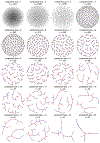A modeling framework to inform preexposure prophylaxis initiation and retention scale-up in the context of 'Getting to Zero' initiatives
- PMID: 31490212
- PMCID: PMC6760326
- DOI: 10.1097/QAD.0000000000002290
A modeling framework to inform preexposure prophylaxis initiation and retention scale-up in the context of 'Getting to Zero' initiatives
Abstract
Objective(s): 'Getting to Zero' (GTZ) initiatives aim to eliminate new HIV infections over a projected time frame. Increased preexposure prophylaxis (PrEP) uptake among populations with the highest HIV incidence, such as young Black MSM, is necessary to accomplish this aim. Agent-based network models (ABNMs) can help guide policymakers on strategies to increase PrEP uptake.
Design: Effective PrEP implementation requires a model that incorporates the dynamics of interventions and dynamic feedbacks across multiple levels including virus, host, behavior, networks, and population. ABNMs are a powerful tool to incorporate these processes.
Methods: An ABNM, designed for and parameterized using data for young Black MSM in Illinois, was used to compare the impact of PrEP initiation and retention interventions on HIV incidence after 10 years, consistent with GTZ timelines. Initiation interventions selected individuals in serodiscordant partnerships, or in critical sexual network positions, and compared with a controlled setting where PrEP initiators were randomly selected. Retention interventions increased the mean duration of PrEP use. A combination intervention modeled concurrent increases in PrEP initiation and retention.
Results: Selecting HIV-negative individuals for PrEP initiation in serodiscordant partnerships resulted in the largest HIV incidence declines, relative to other interventions. For a given PrEP uptake level, distributing effort between increasing PrEP initiation and retention in combination was approximately as effective as increasing only one exclusively.
Conclusion: Simulation results indicate that expanded PrEP interventions alone may not accomplish GTZ goals within a decade, and integrated scale-up of PrEP, antiretroviral therapy, and other interventions might be necessary.
Figures


Similar articles
-
Projecting the number of new HIV infections to formulate the "Getting to Zero" strategy in Illinois, USA.Math Biosci Eng. 2021 May 6;18(4):3922-3938. doi: 10.3934/mbe.2021196. Math Biosci Eng. 2021. PMID: 34198418 Free PMC article.
-
Stimulant use interventions may strengthen 'Getting to Zero' HIV elimination initiatives in Illinois: Insights from a modeling study.Int J Drug Policy. 2022 May;103:103628. doi: 10.1016/j.drugpo.2022.103628. Epub 2022 Feb 24. Int J Drug Policy. 2022. PMID: 35218990 Free PMC article.
-
Preexposure prophylaxis guidelines have low sensitivity for identifying seroconverters in a sample of young Black MSM in Chicago.AIDS. 2018 Jan 28;32(3):383-392. doi: 10.1097/QAD.0000000000001710. AIDS. 2018. PMID: 29194116 Free PMC article.
-
The preexposure prophylaxis revolution; from clinical trials to programmatic implementation.Curr Opin HIV AIDS. 2016 Jan;11(1):80-6. doi: 10.1097/COH.0000000000000224. Curr Opin HIV AIDS. 2016. PMID: 26575147 Free PMC article. Review.
-
PrEParing Women to Prevent HIV: An Integrated Theoretical Framework to PrEP Black Women in the United States.J Assoc Nurses AIDS Care. 2018 Nov-Dec;29(6):835-848. doi: 10.1016/j.jana.2018.03.005. Epub 2018 Apr 5. J Assoc Nurses AIDS Care. 2018. PMID: 29685648 Free PMC article. Review.
Cited by
-
Impact of post-incarceration care engagement interventions on HIV transmission among young Black men who have sex with men and their sexual partners: an agent-based network modeling study.Lancet Reg Health Am. 2023 Nov 10;28:100628. doi: 10.1016/j.lana.2023.100628. eCollection 2023 Dec. Lancet Reg Health Am. 2023. PMID: 38026447 Free PMC article.
-
Agent-based model projections for reducing HIV infection among MSM: Prevention and care pathways to end the HIV epidemic in Chicago, Illinois.PLoS One. 2022 Oct 17;17(10):e0274288. doi: 10.1371/journal.pone.0274288. eCollection 2022. PLoS One. 2022. PMID: 36251657 Free PMC article.
-
Characterizing the Impact of the COVID-19 Pandemic on HIV PrEP care: A Review and Synthesis of the Literature.AIDS Behav. 2023 Jul;27(7):2089-2102. doi: 10.1007/s10461-022-03941-w. Epub 2022 Dec 2. AIDS Behav. 2023. PMID: 36459263 Free PMC article. Review.
-
Loss to Follow-Up and Re-Engagement in HIV Pre-Exposure Prophylaxis Care in the United States, 2013-2019.AIDS Patient Care STDS. 2021 Jul;35(7):271-277. doi: 10.1089/apc.2021.0074. AIDS Patient Care STDS. 2021. PMID: 34242092 Free PMC article.
-
"Make it more than a pill, make it an experience of health:" results from an open pilot intervention to retain young African American men who have sex with men in PrEP care.AIDS Care. 2024 Apr;36(4):472-481. doi: 10.1080/09540121.2023.2221422. Epub 2023 Jun 18. AIDS Care. 2024. PMID: 37331017 Free PMC article. Clinical Trial.
References
-
- Joint United Nations Programme on HIV/AIDS (UNAIDS). Getting to Zero: 2011-2015 Strategy. 2010; :ISBN 978-92-9173-883-0.
-
- National Alliance of State and Territorial AIDS Directors (NASTAD). ENDING THE HIV EPIDEMIC: JURISDICTIONAL PLANS. 2018.
-
- Getting to Zero Exploratory Workgroup. Getting To Zero: A Framework to Eliminate HIV in Illinois. ; 2017. https://www.aidschicago.org/resources/content/1/1/1/3/documents/GTZ_fram... (accessed 2 Oct2018).
-
- Khanna AS, Skwara A, Collier N, Ozik J, Issema R, Di Paola A, et al. Getting to Zero: Triangulating HIV Incidence Predictions from Micro-Level Network Modeling and Macro-Level Incidence Projections In: Society for Prevention Research.Washington, D.C.: ; 2018. https://spr.confex.com/spr/spr2018/webprogram/Session8631.html
-
- Illinois Department of Public Health. Data and Statistics: HIV Fact Sheets: Men Who Have Sex with Men ; 2016. http://www.dph.illinois.gov/sites/default/files/publications/MSM-Factshe... (accessed 2 Oct2018).

